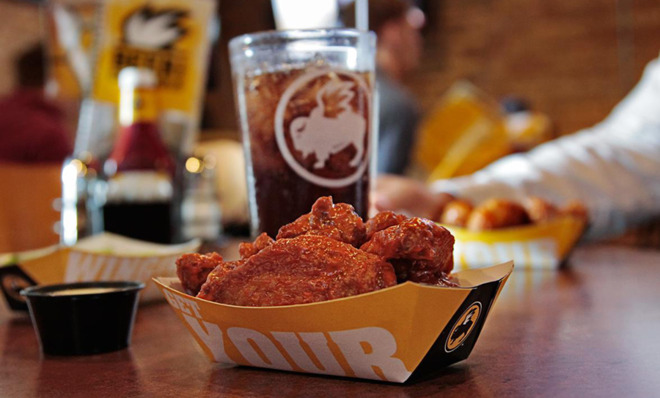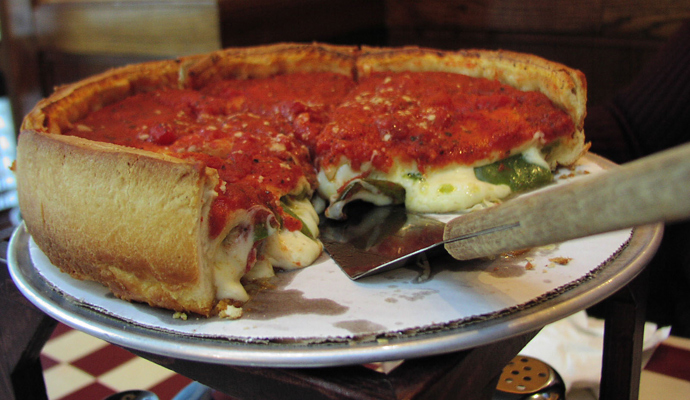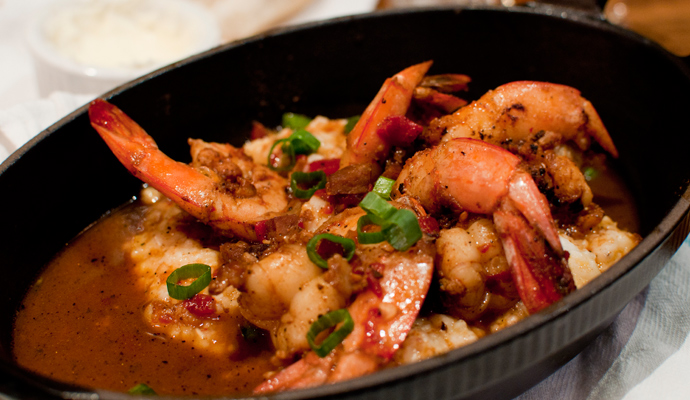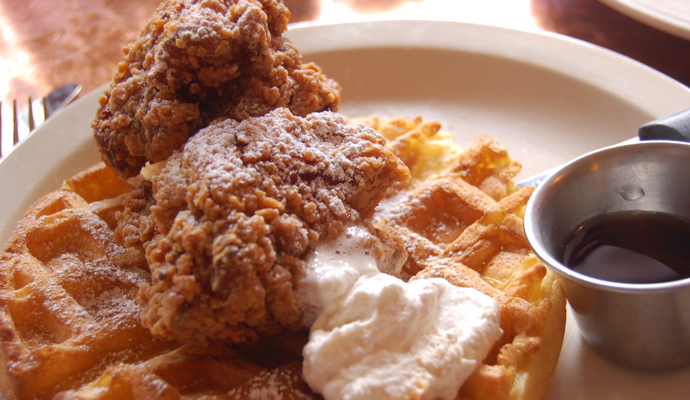The strange world of USDA place labels
Place names qualified with "style" require very specific preparations or ingredients. Here are 25.


One of the jobs of the USDA's Food Safety and Inspection Service is to protect consumers by ensuring that food labels are accurate and not misleading. So it generally requires that when a product is described with a place name, e.g., Virginia Ham, it should actually come from that place. However, things aren't always that simple. Some place names are simply a convenient way to refer to a type of food: We don't expect that Swiss Cheese really comes from Switzerland, and we accept that certain adjectives — Italian, Chinese, Thai — name a certain food style or flavor profile apart from geographical origin.
The FSIS guidelines state that you can use a place name when a product doesn't come from that place if it is clearly part of a trademark name ("Swiss Chalet") or is qualified by the word "brand," as in "Milwaukee Brand Bacon, Made in Chicago, Illinois." You can also use place names to describe certain food preparation styles if they are qualified by the word "style," as in "Buffalo Style Chicken." However "style" is not always required, nor is it always allowed. And place names qualified with "style" require specific preparations or ingredients to be used. Because of these complications, the guidelines for place names on product labels can be quite complex. Here are 25 place names and the restrictions on their use on food labels.
1. ARKANSAS
The Week
Escape your echo chamber. Get the facts behind the news, plus analysis from multiple perspectives.

Sign up for The Week's Free Newsletters
From our morning news briefing to a weekly Good News Newsletter, get the best of The Week delivered directly to your inbox.
From our morning news briefing to a weekly Good News Newsletter, get the best of The Week delivered directly to your inbox.
Arkansas Bacon is a very specific cut of pork prepared in a very specific manner. According to the guidelines it must come from the pork shoulder blade Boston roast, which "includes the porcine muscle, fat and bone, cut interior of the second or third thoracic vertebrae, and posterior of the atlas joint (first cervical vertebrae), and dorsal of the center of the humerus bone." Then, "the neck bones and rib bones are removed by cutting close to the underside of those bones. The blade bone (scapula) and the dorsal fat covering, including the skin (clear plate), are removed, leaving no more than one-quarter inch of the fat covering the roast. The meat is then dry cured with salt, sugar, nitrites, and spices, and smoked with natural smoke." If you make this bacon outside the state of Arkansas you have to call it Arkansas Style Bacon.
2. BUFFALO
This one is a bit confusing because it can refer to a place or an animal. Buffalo Wings is allowed under an exception for "fanciful terms" — everyone knows buffaloes don't have wings! — but even that still has to be accompanied by a description ("chicken wing sections coated in a spicy sauce"). If something else has a sauce with cayenne pepper, vinegar, salt, and garlic, it can be called Buffalo Style.
3. CAJUN
A free daily email with the biggest news stories of the day – and the best features from TheWeek.com
To be Cajun, it has to be made in Louisiana. But if it's seasoned with onion, garlic, white pepper, red pepper, and black pepper it can be labeled Cajun Style.
4. CANADIAN
When it comes to Canadian Bacon, Canadian is detached from its geographical sense. You can call your product Canadian Bacon as long as it meets the specific requirements for a particular preparation of boneless pork loin.
5. CHICAGO

A pizza can be labeled Chicago Style if the cheese is placed directly on the crust, with the meat, and then the sauce, on top of that. "Condimental quantities of a grated cheese may then be placed on the top."
6. CHINESE
Chinese Style can be used for a product "that is enhanced in a solution with soy sauce, grain alcohol or dry sherry wine, and a sweetener, i.e., sugar or honey. Other ingredients may include garlic or scallions, ginger or ginger juice, sesame or peanut oil."
7. COUNTRY
Surprisingly, to be called Country, a product actually must be made in the country (defined as an "unincorporated area"). However, Country Fried does not have to meet that qualification, referring just to a breaded and fried preparation. Country Style can be used for products not made in the country under a few different conditions: for chicken, only if it's cut up chicken where the wishbone is left intact; for sausage, if it's prepared with only natural spices; for steak, if it's a gravy-covered steak that's been tenderized and then browned by sautéing or in an oven (not cooked by flame or in water).
8. ENGLISH OR AUSTRALIAN
A pie can be labeled English Style or Australian Style if it contains at least 25 percent meat or meat byproduct in gravy and has a puff pastry top. No vegetables though.
9. HUNGARIAN
Goulash can be labeled Hungarian Style if it has paprika and at least 25 percent meat (or 12 percent poultry meat). It cannot contain noodles, potatoes or dumplings.
10. IRISH
A stew can be called Irish Stew if it is not made in Ireland as long as it meets certain stew requirements, such as containing lamb, mutton, or beef as well as a selection of vegetables (onions, carrots, potatoes, and turnips). Dumplings may be present, but beans may not be.
11. ITALIAN
A sausage can be Italian Sausage if it contains "at least 85 percent meat, or a combination of meat and fat with the total fat content constituting not more than 35 percent of the finished product. It contains salt, pepper, fennel and/or anise and no more than 3 percent water. Optional ingredients permitted in Italian Sausages are spices (including paprika) and flavorings, red or green peppers, onions, garlic and parsley, sugar dextrose and corn syrup." A product of any kind can be labeled Italian Style if it has anise, or fennel, or an Italian type cheese (e.g., Mozzarella, Parmesan, Provolone, Ricotta, Romano). It can also be Italian Style if it contains at least three of the following ingredients: basil, garlic, marjoram, olive oil, oregano. However, if you want to call your Minestrone Soup Italian Style, it must contain zucchini.
12. JAMAICAN
Jamaican Style can be used for products seasoned with allspice, garlic, onion, red pepper, and thyme.
13. MEXICAN
You can call a product Mexican Style if it has at least four of the following ingredients: jalapeno peppers, chili peppers, green chilies, cumin, cayenne peppers, red or green peppers, chili powder, jalapeno powder, Monterey Jack cheese, or cheddar cheese.
14. NEW ORLEANS

New Orleans Style can be applied to products that have at least five out of the following ingredients: roux base, rice, onion, green onions, garlic, celery, bell peppers, cayenne pepper, white pepper, parsley, tomato.
15. NORTH CAROLINA
If your barbeque meat is prepared in a pepper and vinegar solution, you may call it Eastern North Carolina Style.
16. ST. LOUIS
Spareribs are St. Louis Style if "the sternum and the ventral portion of the costal cartilages are removed with the flank portion. This cut is made at a point in which the sternum and costal cartilages are removed dorsal to the curvature of the costal cartilages."
17. SANTA FE
Santa Fe Style may be used for products that contain "chilies with corn or beans and one of the following ingredients: cheese (jack, cheddar, Mexican Style or fresh goat), bell pepper, onion, garlic, tomatoes, tomatillos, cumin, oregano or cilantro. The beans should be either black, kidney, navy, pink, pinto, red, or white beans or an indigenous variety."
18. SICILIAN
For a pizza, if the crust is "50 percent or greater of the total pizza product" you can call it Sicilian Style.
19. SMITHFIELD
A ham can only be called Smithfield Ham if it is an aged, dry-cured ham made in Smithfield, Virginia. You cannot get around this requirement by calling it Smithfield Style or Smithfield Brand. You can't even get around it by producing it in Smithfield, North Carolina.
20. SOUTHERN

Southern only applies for "areas south of the Mason-Dixon Line and east of the Mississippi River as well as Arkansas, Louisiana, and Missouri, which are also considered southern states." But Southern Fried can be used for a product from anywhere that's breaded and fried.
21. SOUTHWESTERN
A product can be labeled Southwestern Style if it has five of the following ingredients: beans, corn, chili peppers, bell peppers, cheddar cheese, cilantro, onions or onion powder, cumin, oregano, garlic or garlic powder, paprika, chili powder, and either mesquite smoked, or with mesquite smoke flavor added.
22. SWEDISH
It doesn't have to be from Sweden to be a Swedish meatball (no need for "style"), but it does have to contain at least 65 percent fresh meat. It usually contains nutmeg, allspice, potatoes and milk too. However "Swedish Brand Meatballs, Made in USA" can be any meatball.
23. SZECHWAN
Szechwan Style can be used for a product containing one item from each of three of the following four groups: 1. Soy sauce; 2. Spring onions, scallions or leeks. 3. Garlic, ginger, ginger root. 4. Chili Szechwan peppercorn, Chili oil.
24. THAI
A product can be labeled Thai Style if it has at least five out of the following ingredients: basil, chilies or chili products, cilantro, coconut or coconut products, coriander, cumin, fish sauce, galangal, garlic, ginger, green onions, jasmine rice, lemon grass, peanuts or peanut products, rice noodles, shallots, or soy sauce.
25. VIETNAMESE
Egg Rolls can be labeled Vietnamese Style only if they "contain soy bean noodles or cellophane noodles, and fish sauce or anchovy extract."
Arika Okrent is editor-at-large at TheWeek.com and a frequent contributor to Mental Floss. She is the author of In the Land of Invented Languages, a history of the attempt to build a better language. She holds a doctorate in linguistics and a first-level certification in Klingon. Follow her on Twitter.



